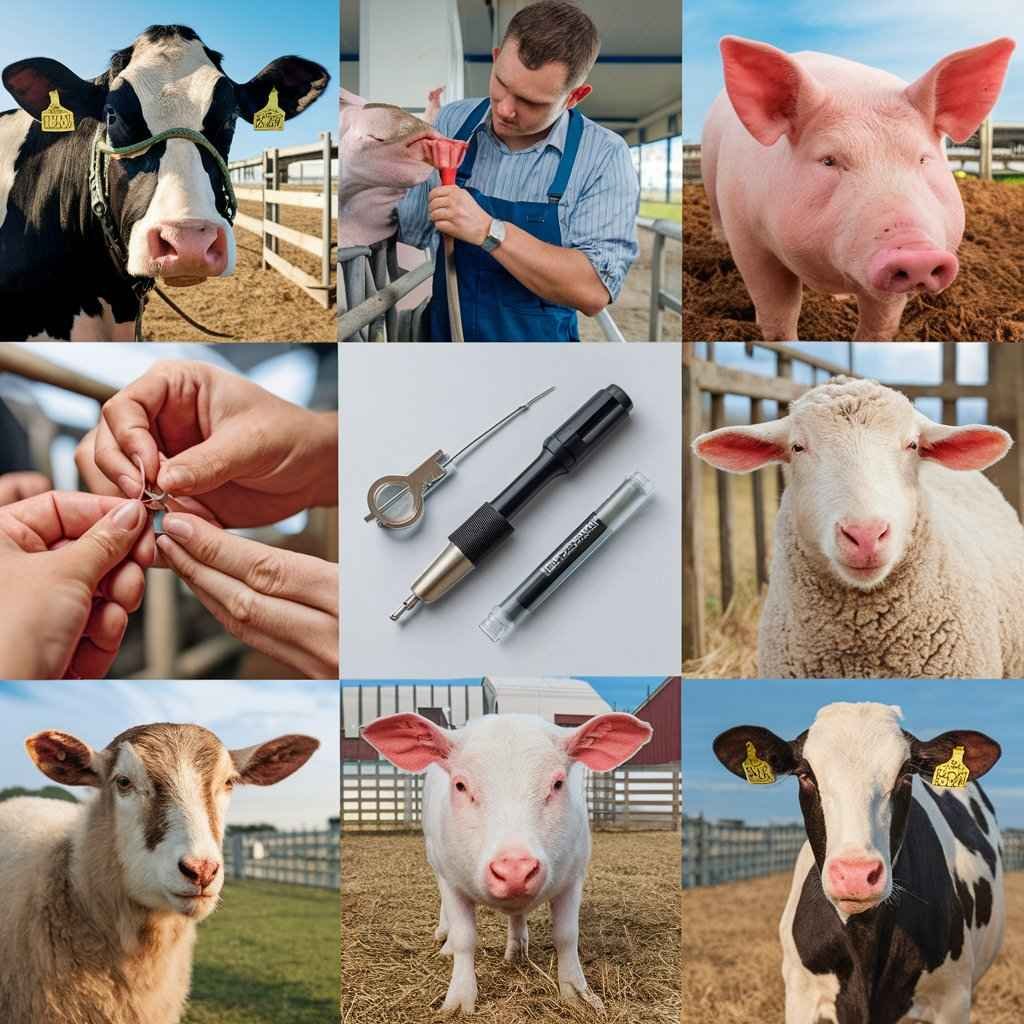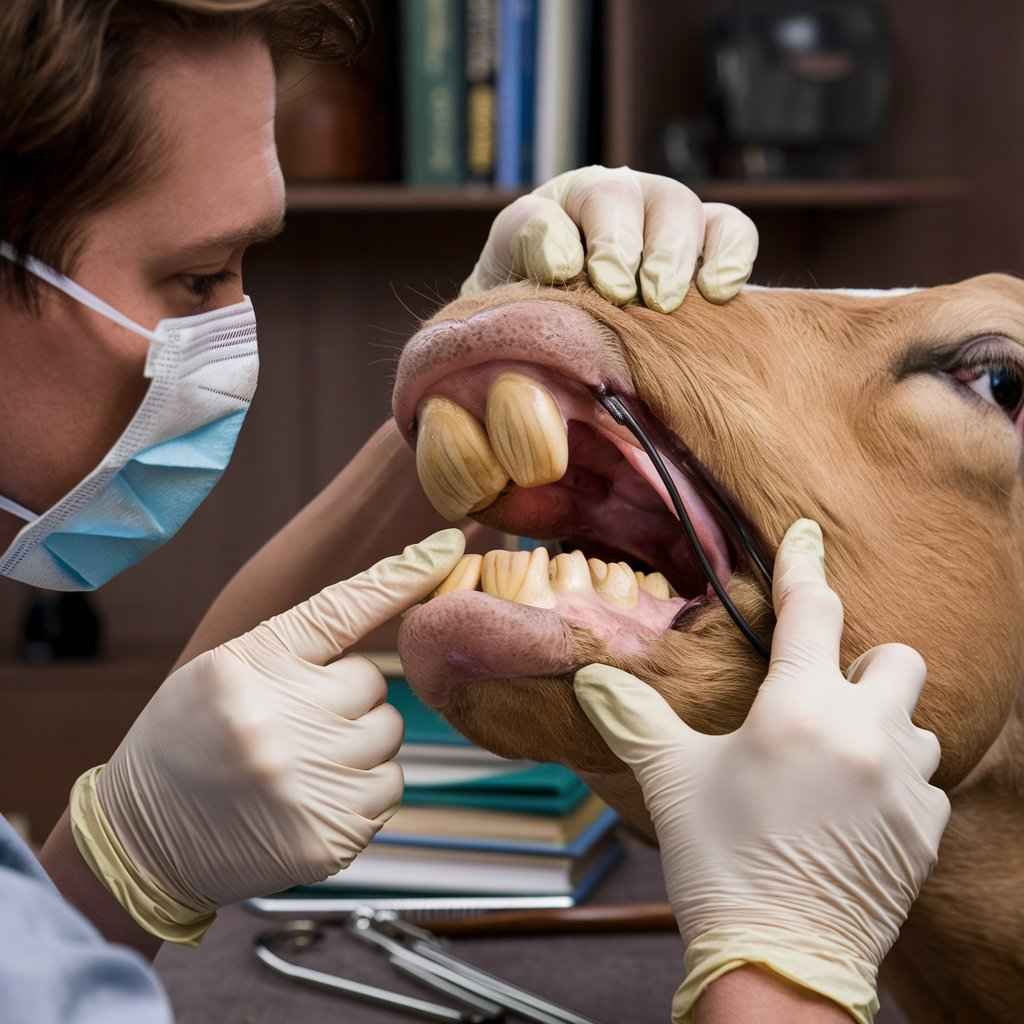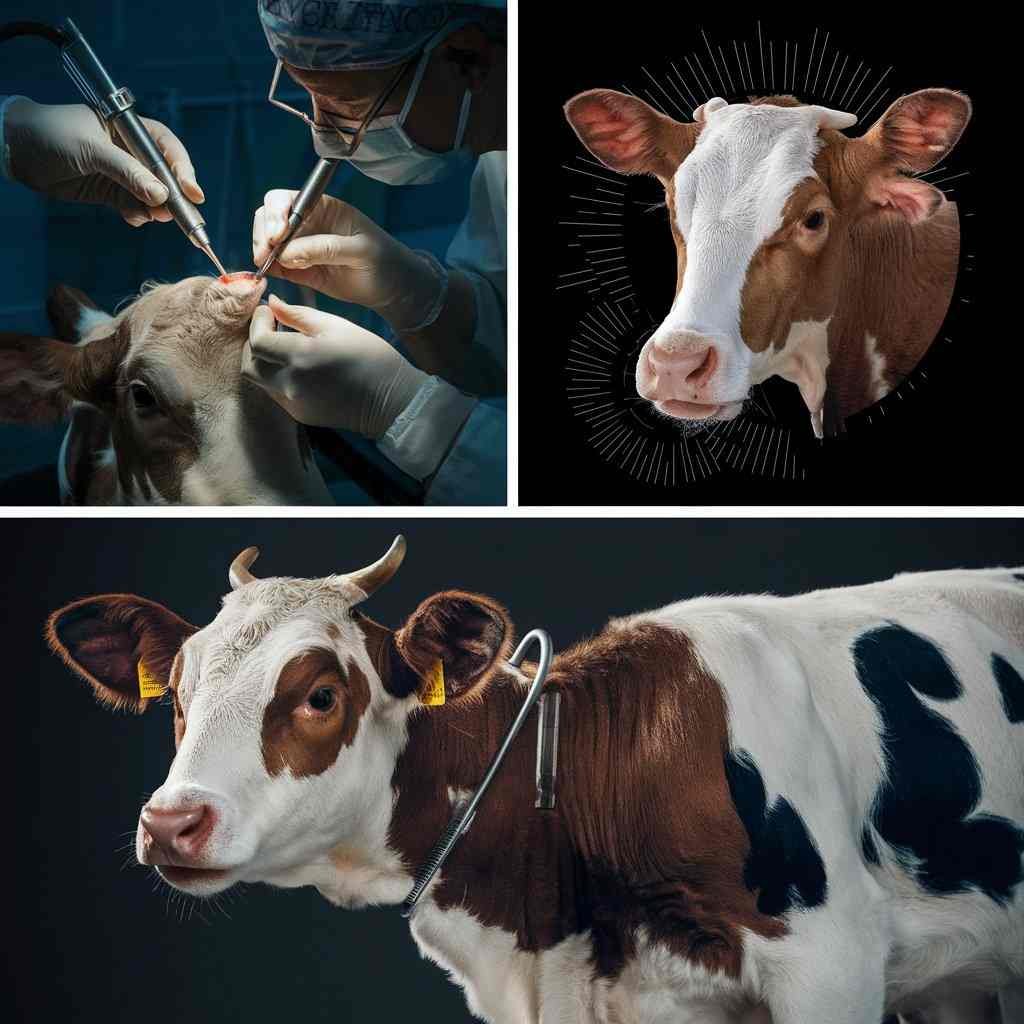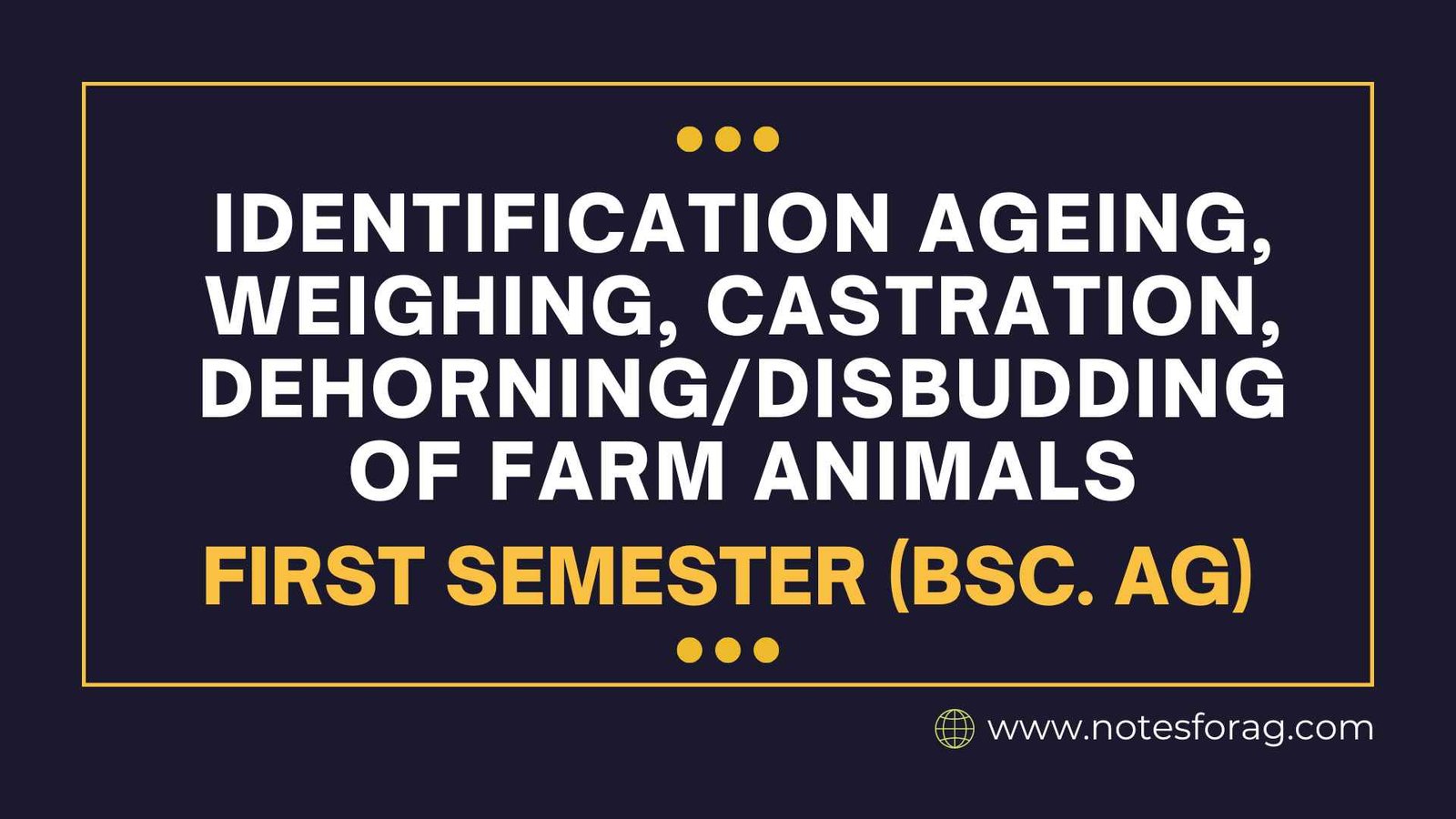Identification, aging, weighing, castrating, and dehorning/disbudding are important procedures in farm animals management that guarantee the productivity, welfare, and health of the animals. Animals can be tracked and managed with the use of identification techniques like microchipping, tattooing, ear tags, and brand marking. Teeth examinations or keeping precise birth records are commonly used to estimate age.
Growth and health can be tracked with regular weighing on scales, weighbridges, or weight tapes. Meat quality is improved and breeding is controlled through castration, which can be done surgically, by banding, or with a Burdizzo. Cauterization or removal techniques used for dehorning or disbudding ensure safety by avoiding injuries. These procedures require careful training, hygienic measures, attention to animal welfare, and regulatory compliance.
Table of Contents
Here’s an overview of key procedures like identification, aging, weighing, castration, and dehorning/disbudding:
Identification Methods for Farm Animals
A key component of livestock management is the identification of farm animals, which guarantees effective record-keeping, health care, and regulatory compliance. Farm animals can be identified using a variety of techniques, each with pros and cons of its own. Here are some commonly used methods:

1) Ear Tags
Description: A unique number or code is written on plastic or metal tags that are fastened to the animal’s ear.
- Easy to apply and read
- Risk of loss or damage
2) Tattooing
Description: Permanent tattoos, typically applied within the ear, using ink.
- Permanent and tamper-proof
- Harder to read
3) Branding
Description: Animals can be permanently identified by hot or freezing branding.
- Permanent
- Painful; requires skill and equipment
4) Microchipping
Description: Subcutaneously implanting a tiny electronic chip that can be scanned to retrieve the animal’s identification.
- Permanent and tamper-proof
- Requires a scanner; more expensive
Any identifying system must be successful in maintaining accurate records. Effective tracking of individual animals for breeding, health management, and regulatory compliance is ensured by keeping thorough records. When putting identification procedures into effect, it’s also critical to take legal obligations and animal welfare rules into account.
Techniques for Determining the Age of Farm Animals
For efficient livestock management, the age of farm animals, including cattle, sheep, goats, and pigs, must be ascertained. Reliability in age estimation is beneficial for market valuation, health management, and breeding decisions. These animals’ ages can be estimated using a variety of visual cues and anatomical traits; different methods work for different species.

1) Teeth Examination
- Cattle: The eruption and wear of the incisors are used to measure age.
- Goats and sheep: Similar to cattle, they emphasize incisors.
- Horses: The quantity, condition, and form of their teeth indicate their age.
2) Horn Rings
- Cattle: A growth ring on the horns can reveal a year’s age (less prevalent in modern practice).
3) Records
- Birth Records: Precise aging can be obtained by accurately recording birth dates.
4) Physical Characteristics
- General Appearance: Though less accurate, physical characteristics such as size, condition, and other characteristics might give an indication of age.
- Bird Feathering: In poultry, especially young birds, the growth of feathers can be a good indicator of age.
Comprehending these methods of determining age is essential to efficient cattle management. Farmers can plan breeding schedules, health care, and market preparedness with confidence when they estimate ages accurately. Farmers can maintain their herds in the best possible health and increase productivity and profitability by using these techniques.
Weighing Farm Animals: Methods and Equipment
Regular weighing helps monitor growth, health, and appropriate feeding:

1) Digital Scales
- Description: Livestock-specific electronic scales.
- Advantages: Quick and accurate readings, frequently with integrated weight-logging features.
- Use: Suitable for individual animals; frequently applied to sheep, pigs, and cattle.
2) Mechanical Scales
- Description: Classical balances including a dial or balance beam.
- Benefits: Long-lasting and dependable; requires no electricity.
- Usage: Handy in isolated locations or situations where electronic scales are not practicable.
3) Weighbridges
- Description: Large platforms that can weigh vehicles transporting animals or groups of animals.
- Benefits: Excellent for weighing a lot of animals or heavy ones.
- Usage: Frequently seen in bigger farms and businesses.
4) Weight Tapes
- Description: Weight estimation based on girth using measuring tapes calibrated for individual animals.
- Benefits: Low cost, lightweight, and simple to use.
- Use: Good for making quick judgments, particularly with horses and livestock.
Considerations
- Animal welfare: Reduce anxiety in animals by being gentle with them and by keeping weighing sessions brief.
- Precision: To ensure precision, make sure scales are calibrated on a regular basis.
- Safety: To protect animals and handlers from harm, use the proper enclosures or restraints.
- Environment: To guarantee accurate measurements, place the scales on a level, sturdy surface.
- Hygiene: To stop the spread of disease, keep the weighing apparatus clean.
Farmers can improve livestock management methods by making well-informed decisions by combining weighing data with other performance and health measures.
Castration and Dehorning/Disbudding: Procedures and Considerations
Castration and dehorning/disbudding are essential livestock management practices that enhance animal welfare, security, and output. In male animals, castration entails removing or inactivating the testicles, usually with the goals of improving meat quality, reducing aggressive behavior, and preventing undesired reproduction.

1. Castration
Purpose
- Control breeding
- Reduce aggressive behavior
- Improve meat quality
Methods
i) Surgical Castration:
- Description: A scalpel is used to remove the testicles.
- Considerations: Needs expertise; minimizes pain and infection risk by using anesthetics and antiseptics.
ii) Banding
- Description: The testicles are made to atrophy by using a tight rubber band to cut off their blood supply.
- Considerations: Safe for puppies; minimal bleeding; keep an eye out for tetanus-related issues.
iii) Burdizzo
- Description: Using a Burdizzo clamp, crush the spermatic cords without rupturing the skin.
- Considerations: Needs expertise; decreased chance of infection, but may cause discomfort; using the right method is essential.
Considerations
- Timing: To reduce stress and complications, perform when still young.
- Pain management: The process of reducing pain by using analgesics and anesthetics.
- Hygiene: To avoid infections, keep things clean.
- Training: Ascertain that handlers have received the appropriate instruction.
- Rules: Adhere to regional statutes and policies pertaining to animal welfare.
2. Dehorning/Disbudding
Purpose
- Prevent harm to handlers and other animals.
- Minimize facility damage
- Boost the safety of handling
Methods
i) Disbudding:
- Hot Iron Disbudding:
- Description: Heating an iron to kill tissue that forms horns in young animals.
- Considerations: Anesthetics can be used to lessen discomfort; effective if done early.
- Chemical Disbudding:
- Description: Stopping the formation of horn buds by applying caustic paste.
- Considerations: Safe for very young animals; if not treated correctly, there is a risk of chemical burns.
ii) Dehorning:
- Mechanical Dehorning:
- Description: Cutting off horns with wire, shears, or saws.
- Considerations: More intrusive; appropriate for senior pets; employ anesthetics and antiseptics to lessen discomfort and infection risk.
Considerations
- Timing: For a simpler and less stressful surgery, perform when young.
- Pain management: To reduce pain, take analgesics and anesthetics.
- Hygiene: Keep things tidy to avoid getting sick.
- Training: Ascertain that handlers are proficient in the process.
- Rules: Adhere to local statutes and policies pertaining to animal welfare.
Castration and dehorning/disbudding are essential practices for managing livestock, but they must be carried out carefully to protect the animals’ wellbeing. These treatments require strict adherence to laws, appropriate timing, pain management, and hygiene.
Frequently Asked Question(FAQ)
Why is animal identification important?
It supports disease control, breeding records, tracking, management, and compliance with regulations.
How often should farm animals be weighed?
Regularly, to check on health, growth, and to make sure the right food is being consumed. The age and stage of production of the animal may have an impact on frequency.
What is the difference between disbudding and dehorning?
Dehorning is the removal of an older animal’s fully developed horns, whereas disbudding is the removal of an animal’s horn buds before they grow.
Related Articles

